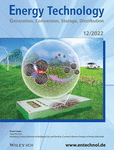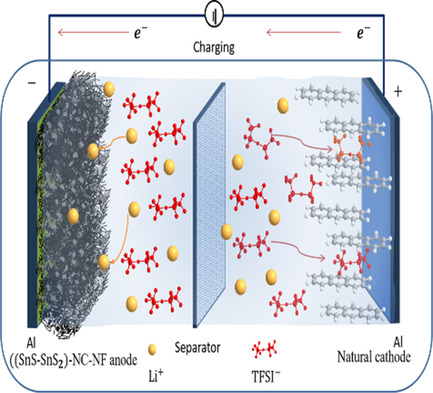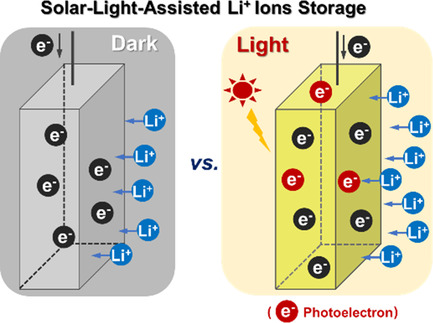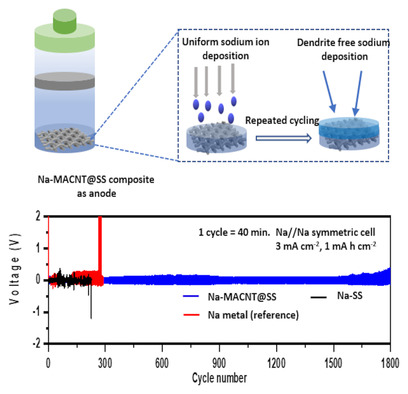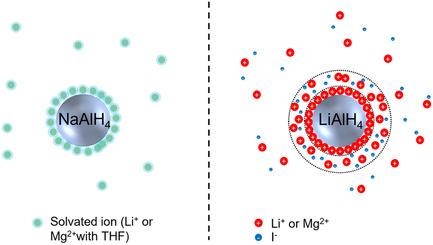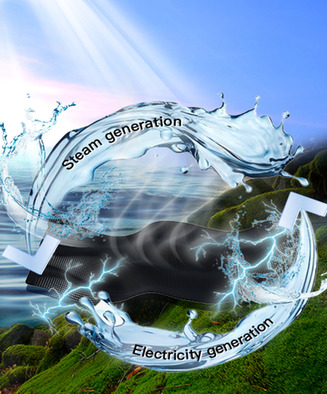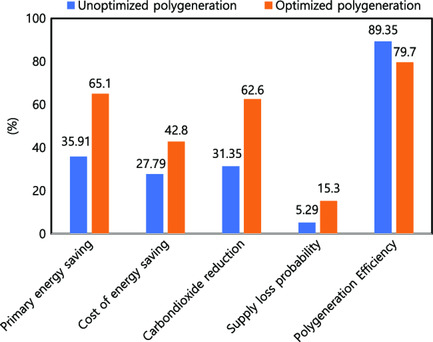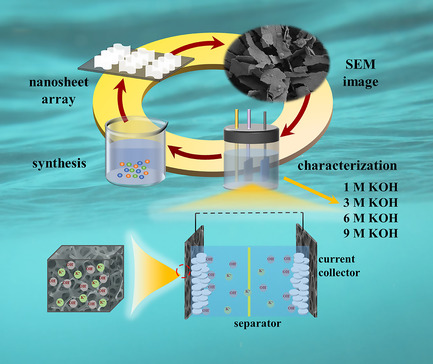Journal list menu
Export Citations
Download PDFs
Cover Picture
Modeling Contact Behavior of Multiparticles and Particle–Current Collector Contact in Porous Electrode
- First Published: 08 December 2022
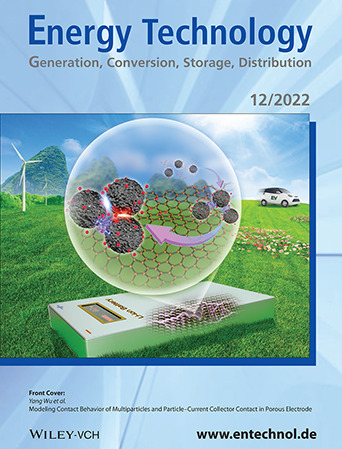
An electrochemical–mechanical representative volume element model is developed to study the contact behavior of porous electrodes. Stronger constraints and larger size differences enhance the reduction in the Li-ion concentration and contact stress. Decreasing elastic modulus of the current collector significantly reduces the contact stress of particles. Results provide insights into designing Li-ion batteries from the perspective of contact stress. More details can be found in article number 2200786, Zhan-Sheng Guo and co-workers.
Inside Front Cover
Bifunctional Mesoporous MO x (M = Cr, Fe, Co, Ni, Ce) Oxygen Electrocatalysts for Platinum Group Metal-Free Oxygen Pumps
- First Published: 08 December 2022
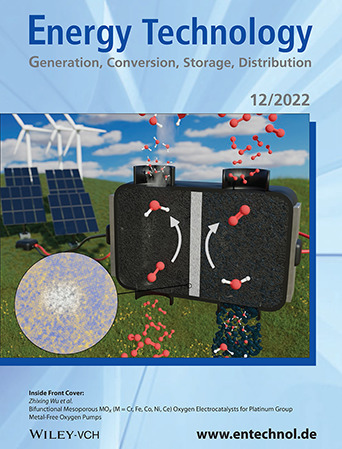
A family of crystalline mesoporous metal oxides was synthesized via a soft-templated hydrothermal synthesis route and evaluated as electrocatalysts for oxygen evolution and reduction reactions. The mesoporous NiO was used to elaborate, for the first time, a symmetrical platinum group metal-free oxygen pump. More details can be found in article number 2200927, Zhixing Wu and co-workers.
Back Cover
FlexTrail Printing as Direct Metallization with Low Silver Consumption for Silicon Heterojunction Solar Cells: Evaluation of Solar Cell and Module Performance
- First Published: 08 December 2022
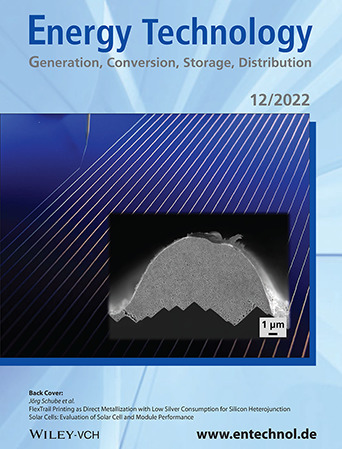
The cover image shows an in-situ photography of a nanosilver FlexTrail printing process being applied to high efficiency silicon heterojunction solar cells. Moreover, a scanning electron micrograph of a FlexTrail nanosilver electrode on an alkaline textured silicon heterojunction substrate is presented. Such electrodes exhibit a mean shading finger width of (12.7 ± 0.4) μm and allow for great silver saving. More details can be found in article number 2200702, Jörg Schube and co-workers.
Masthead
Correction
Directly Spun Epoxy-Crosslinked Polyethylenimine Fiber Sorbents for Direct Air Capture and Postcombustion Capture of CO2
- First Published: 21 October 2022
Perspective
A Perspective on Innovative Drying Methods for Energy-Efficient Solvent-Based Production of Lithium-Ion Battery Electrodes
- First Published: 12 October 2022
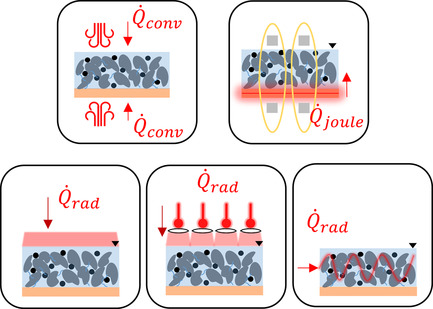
To lower the CO2 footprint of lithium-ion battery production, the authors suggest more efficient innovative electrode drying technologies. The presented technologies—a) conventional convective, b) contact heating via induction, c) infrared drying, d) VCSE-Laser drying, and e) microwave drying—are evaluated and a combination of convective and inductive drying for simultaneous double-sided coating is proposed.
Reviews
Advances in Anode Materials for Microbial Fuel Cells
- First Published: 16 September 2022
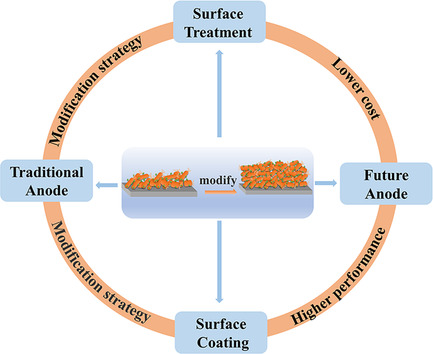
Based on the introduction of traditional anode materials, this review summarizes novel anode modification strategies including surface coating and surface modification. Among them, the modification strategy based on high-performance materials is emphatically introduced. Finally, in order to realize the improvement and commercial application of microbial fuel cells, the challenges and prospects of anode development in the future are discussed.
Review on Recent Applications of Nitrogen-Doped Carbon Materials in CO2 Capture and Energy Conversion and Storage
- First Published: 22 September 2022
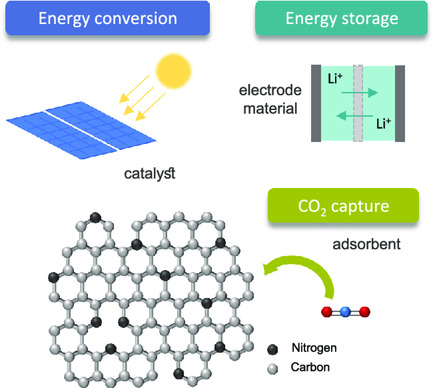
Nitrogen-doped carbon materials have emerged in various fields due to synergistic effects gained from doping. Among other factors, level of doping and porosity have the most effect in the performance of these materials. This review discusses the recent progress of N-doped carbon materials in CO2 capture, energy conversion, and energy storage and highlights feasible strategies for improvements.
Research Articles
Modeling Contact Behavior of Multiparticles and Particle–Current Collector Contact in Porous Electrode
- First Published: 06 October 2022
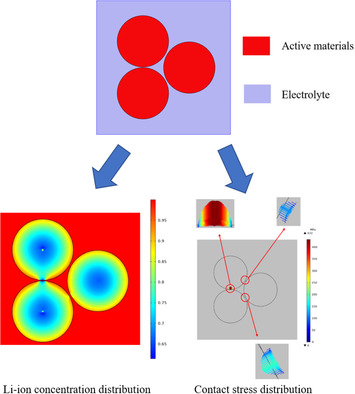
An electrochemical–mechanical representative volume element model is developed to study the contact behavior of porous electrodes. Stronger constraints and larger size differences enhance the reduction in the Li-ion concentration and contact stress. Decreasing elastic modulus of the current collector significantly reduces the contact stress of particles. Results provide insights into designing Li-ion batteries from the perspective of contact stress.
Bifunctional Mesoporous MO x (M = Cr, Fe, Co, Ni, Ce) Oxygen Electrocatalysts for Platinum Group Metal-Free Oxygen Pumps
- First Published: 21 September 2022
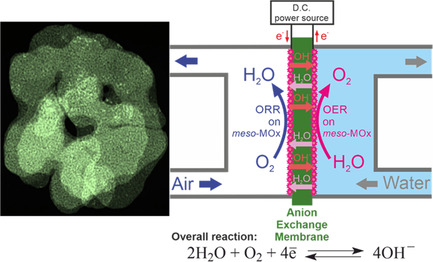
The family of high-quality crystalline mesoporous MOx synthesized via soft-templated hydrothermal synthesis is investigated in oxygen reduction reaction and oxygen evolution reaction electrocatalysis. Using developed NiO, the symmetrical platinum group metal-free oxygen pump is elaborated for the first time.
FlexTrail Printing as Direct Metallization with Low Silver Consumption for Silicon Heterojunction Solar Cells: Evaluation of Solar Cell and Module Performance
- First Published: 22 September 2022
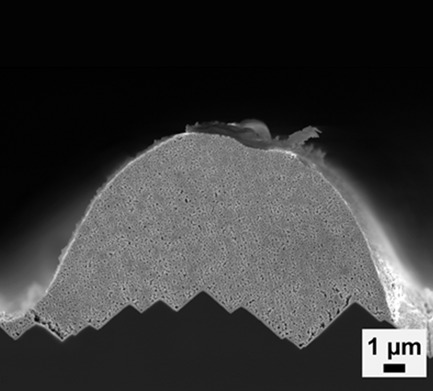
Herein, FlexTrail printing is further developed for direct metallization of silicon heterojunction solar cells. Compared to screen printing, FlexTrail allows for a silver reduction of more than 60% without significant efficiency losses of busbarless cells, promising a great cost-saving potential. Using multiwire interconnection, one-cell modules with FlexTrail-printed front contacts reach up to (5.0 ± 0.1) W.
A Solid-State Carrier Transport-Prompted Z-Scheme BiVO4 Quantum Dots-Based Photocatalyst for Boosted Photocatalytic Degradation of Antibiotics
- First Published: 25 August 2022
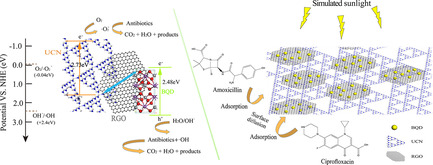
A solid-state carrier transport-prompted Z-scheme BiVO4 quantum dot-based photocatalyst is synthesized for improved photocatalytic degradation of antibiotics. Under simulated sunlight exposure, the BQD/RGO/UCN composite can address the limited electron diffusion length and severe recombination exists in traditional BiVO4 photocatalysts due to the efficient photogenerated carriers and speedy electron transport.
3D Cellulose Graphene Aerogel with Self-Redox CeO2 as Li2S Host for High-Performance Li–S Battery
- First Published: 14 September 2022
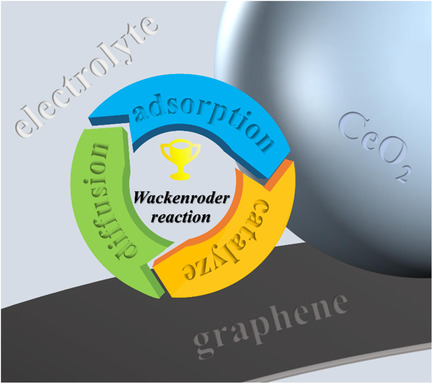
Cellulose graphene aerogel (CGA) reveals a 3D interconnected structure. The introduced CeO2 crystal possesses the self-redox property that can partly convert the valence state of the Ce element. Ce4+ can promote the reaction kinetics of the Li–S battery by oxidizing LiPSs to thiosulfate. The prepared Li2S-CGA/CeO2 cathode exhibits excellent electrochemical properties.
A Li-Ion Battery Using Nanostructured Sn@C Alloying Anode and High-Voltage LiNi0.35Cu0.1Mn1.45Al0.1O4 Spinel Cathode
- First Published: 22 September 2022
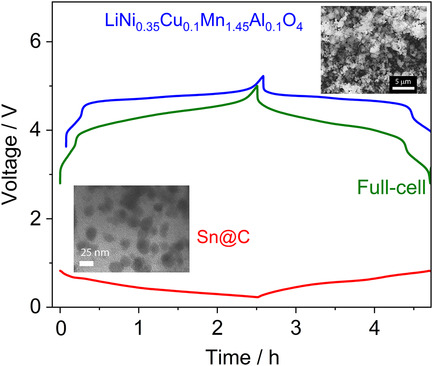
A cobalt-free Li-ion battery with the Sn@C/LiNi0.35Cu0.1Mn1.45Al0.1O4 configuration is successfully achieved and tested, starting from the active material synthesis and characterization. Based in the experimental results, the new full cell operating at 4.2 V with a specific capacity of 110 mAh g−1 is proposed as a possible alternative to the presently commercialized energy storage systems.
Coordination Anchoring Effect Promoting the Interfacial Stability and Electrochemical Performance of LiNi0.8Co0.1Mn0.1O2 Cathode Material for Lithium-Ion Batteries
- First Published: 31 August 2022
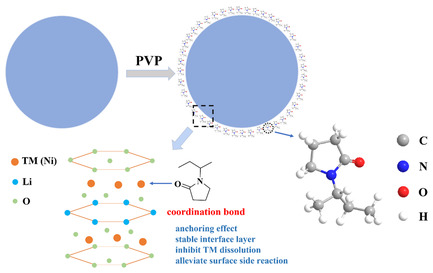
Polyvinyl pyrrolidone (PVP) with a C=O bond is introduced to the surface of the cathode material, which forms strong coordination bonds with transition metal ions and greatly reduces the fall of the coating. Meanwhile, the implanted organic coating can inhibit the side reaction. This novel strategy provides a new insight into the modification of cathode materials.
Photothermal-Induced Electrical Behavior of Micron-Sized Platinum Structures and Their Efficient Photodetection
- First Published: 06 September 2022
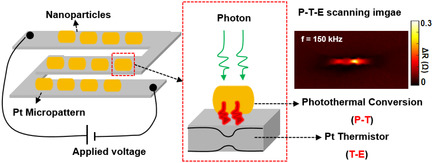
Herein, based on precisely designed Pt structures and a scanning near-field optical microscopy setup, direct evidence is provided for the ultrafast photothermal-induced electrical behavior of a platinum microwire (Pt MW). By combining it with the metal nanoparticles (e.g., Au NRs) with photothermal conversion ability, the hybrid Au NRs/Pt MWs devices can successfully realize high-performance photo-thermo-electric detection.
Sb/N-Doped Carbon Nanofiber as a Sodium-Ion Battery Anode
- First Published: 20 September 2022
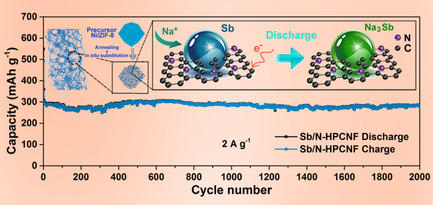
Herein, a hybrid of antimony nanoparticles and N-doped hollow porous hard carbon nanofiber (Sb/N-HPCNF) is designed and synthesized by electrospinning and solvothermal reaction. As an anode of sodium-ion battery, Sb/N-HPCNF presents excellent cycling stability (281 mAh g−1 after 2000 cycles at 2 A g−1).
Improved Compound Correction-Electrical Equivalent Circuit Modeling and Double Transform-Unscented Kalman Filtering for the High-Accuracy Closed-Circuit voltage and State-of-Charge Co-Estimation of Whole-Life-Cycle Lithium-Ion batteries
- First Published: 27 September 2022
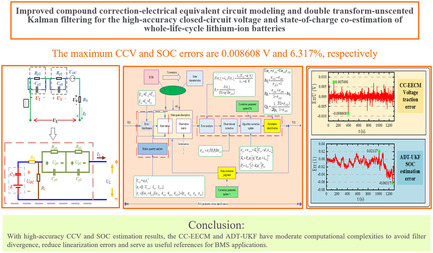
Improved compound correction-electrical equivalent circuit modeling and double transform-unscented Kalman filtering methods are proposed for high-accuracy closed-circuit voltage and state-of-charge co-estimation of whole-life-cycle lithium-ion batteries under varying temperatures and complex working conditions. For a temperature range of 5–45 °C, the proposed method responds well with a maximum error of 0.008608 V and 6.317%, respectively.
Theoretical Modeling of Perovskite–Kesterite Tandem Solar Cells for Optimal Photovoltaic Performance
- First Published: 20 September 2022
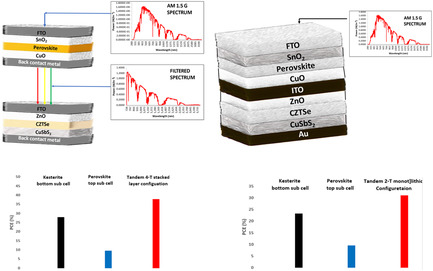
This study reports a power conversion efficiency of 31.15% and 37.84%, respectively, for a monolithic two-terminal (2-T) and a mechanically stacked four-terminal (4-T) tandem solar cell consisting of a top FA0.83Cs0.17PbI1.5Br1.5 perovskite subcell and a bottom Cu2ZnSnSe4 kesterite subcell after device optimization using 1D tool.
Inverted Hysteresis in n–i–p and p–i–n Perovskite Solar Cells
- First Published: 24 August 2022
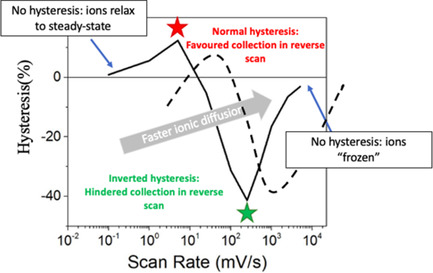
Hysteresis is a dynamic effect endemic to perovskite solar cells. Herein, it is demonstrated that under the right conditions, n–i–p and p–i–n cells can show normal or inverted hysteresis depending on the scan rate. Studies of inverted hysteresis are supported by a model allowing for coupled electron–ion motion.
Electrochemical Properties of Chitosan-Modified PbO2 as Positive Electrode for Lead–Acid Batteries
- First Published: 22 September 2022
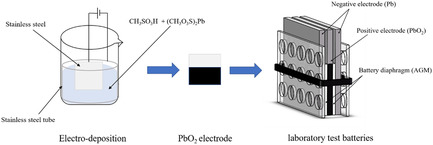
Using chitosan (CS) and fluorine as additives, the PbO2–CS–NaF positive electrode material is prepared by electrodeposition. The positive electrode material has good stability and large electrochemical activity. The first charge and discharge capacity of the lead–acid battery assembled with the modified material is 4257 mAh, and the discharge-specific capacity is 196 mAh g−1 after 500 cycles.
Lithium-Rich Li[Li0.2Ni0.2Mn0.6]O2/Hierarchical Porous Graphitic Carbon Composites Promoters for Polysulfides Regulation in Lithium–Sulfur Batteries
- First Published: 25 September 2022
![Lithium-Rich Li[Li0.2Ni0.2Mn0.6]O2/Hierarchical Porous Graphitic Carbon Composites Promoters for Polysulfides Regulation in Lithium–Sulfur Batteries](/cms/asset/7000bb79-4516-448d-967e-c8869b16321c/ente202200800-blkfxd-0001-m.jpg)
Lithium-rich Li[Li0.2Ni0.2Mn0.6]O2/hierarchical porous graphitic carbon composite (LLNM/HPGC) is first synthesized as a sulfur host, aiming to restrict the shuttle effect of polysulfides via physical entrapment from 3D HPGC and catalyze the conversion of polysulfides from LLNM. Benefiting from the well-constructed host framework, 1Gly-LLNM/2HPGC@S with optimal ratio shows excellent cycle performances and rate capability for lithium–sulfur batteries.
Influence of Ice Templating on Oxygen Reduction Catalytic Activity of Metal-Free Heteroatom-Doped Mesoporous Carbon Derived from Polypyrrole for Zinc–Air Batteries
- First Published: 28 September 2022
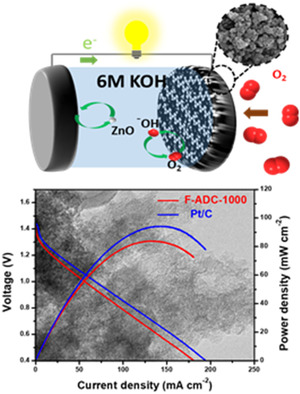
A heteroatom (N, P, S)-doped metal-free electrocatalyst for oxygen reduction reaction from polypyrrole hydrogel is prepared through carbonization processes. The ice templating and freeze drying of hydrogel precursor help in the porosity and microstructure engineering of the derived electrocatalyst. Ultimately, this work depicts a facile and rational synthesis of a truly metal-free electrocatalyst for the primary zinc anode batteries that can be a potential replacement for state-of-the-art systems.
Sn Nanoparticles Anchored on Carbon Foam Prepared by a Facile Electrodeposition for Lithium Storage
- First Published: 30 September 2022
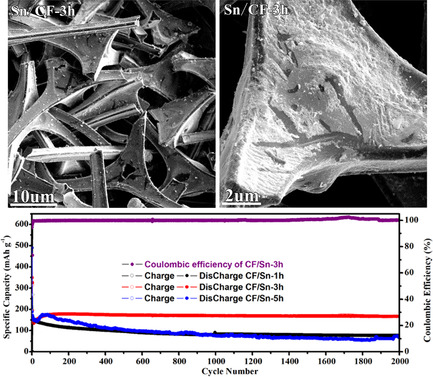
A simple preparation method for the Sn–carbon composites (Sn/CF) is designed by electrodepositing Sn nanoparticles on 3D carbon foam (CF). The Sn/CF electrode can provide a 3D conductive network, accommodate volume changes to prevent Sn nanoparticles from losing electrical contact, and promote contact with electrolytes to accelerate lithium-ion transmission, resulting in high specific capacity and excellent long-term cycling stability.
From Cathodes to Conductive Pastes: A New Perspective into the Recycle of Silver Element
- First Published: 14 September 2022
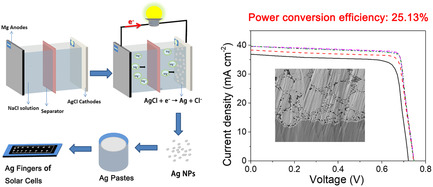
A novel strategy enables to realize the recycle of silver element from batteries to photovoltaics. Aqueous Mg/AgCl batteries with high power density are fabricated. Ag nanoparticles (NPs) can be obtained from the waste aqueous Mg/AgCl batteries. The introduction of Ag NPs significantly improves the power conversion efficiency of heterojunction solar cells.
Energy Optimization Based on Steam System Analysis and Waste Energy Recovery for Iron and Steel Industry
- First Published: 28 September 2022
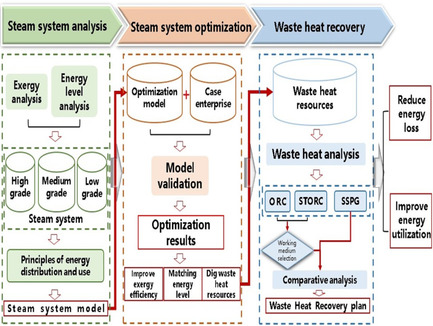
Based on the theory of exergy analysis and energy level analysis, an optimization model of steam system is established. According to the waste heat resources excavated in the optimization process, several recovery technologies are compared, and a recovery scheme is put forward. The purpose of this study is to reduce energy loss and improve energy utilization.
Split Injection Strategy Optimization to Achieve Ideal Stratified-Charge Mixture and Reinforce Ultralean Burn in a High Compression Ratio Direct Injection Spark Ignition Engine
- First Published: 14 September 2022
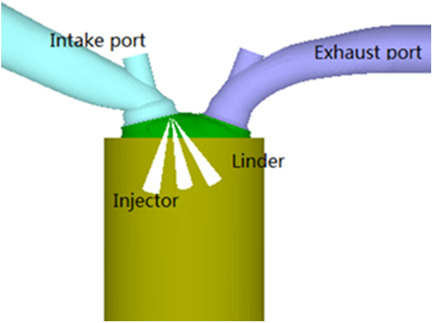
The high compression ratio under ultralean condition is the effective way to achieve high-efficiency combustion in the engine. Herein, the mixture distribution, combustion characteristics, and emissions of a high compression ratio (17:1) engine are numerically simulated to investigate an ideal stratified-charge mixture behavior under excess air ratio of 2.0.
Numerical Investigation of Compressive Stress and Wettability Effects on Fluid Transport in Polymer Electrolyte Membrane Fuel Cell Porous Layers
- First Published: 21 September 2022

A numerical framework is presented highlighting effects of compressive stress on fluid transport across multiple porous layers in polymer electrolyte membrane fuel cells. Liquid transport characteristics under various compressive conditions are mainly influenced by pore-scale capillary pressure. An adequate compression stress level can facilitate liquid drainage and gas transport at the interface between microporous and catalyst layers during operation.
Selectively Harvesting Nonvisible Photons in Hybrid Solar Lighting Systems for Power Generation in Buildings
- First Published: 30 September 2022
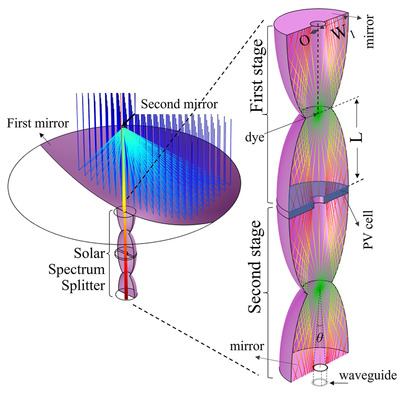
Hybrid solar lighting systems are integrated with parabolic- and elliptic-shaped solar spectrum splitters (SSSs) that partition collimated solar radiation into its visible and nonvisible parts. The nonvisible light is used to generate electricity in photovoltaic (PV) cells and the visible light is used for indoor lighting. A nonvisible-light-to-electricity conversion efficiency of ≈13.4% is achieved for light entering the SSS.
Role of Halide Substitution in Perovskite-Based Asymmetric Hybrid Supercapacitor
- First Published: 30 September 2022
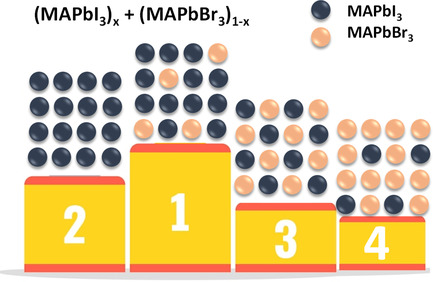
The role of halide substitution on the charge storage efficiency in a hybrid perovskite supercapacitor has been investigated. Methylammonium lead tri-bromide and methylammonium lead tri-iodide powders obtained from the single crystals are mixed together to prepare the porous electrode. Increasing the iodide increases the charge storage capacity due to increased ionic conductivity. However, overall device stability decreases as the iodide content increases.
Polyvinylidene Fluoride-Based Vibration Energy Harvester with Piezoelectric and Electromagnetic Effects
- First Published: 06 October 2022
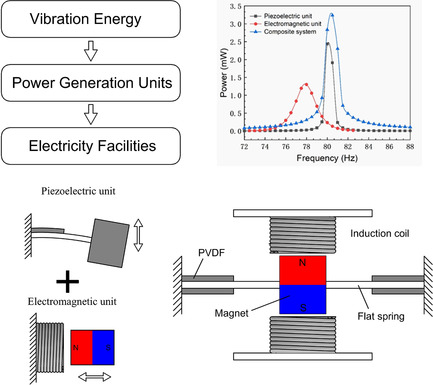
A vibration energy collector consisting of an electromagnetic unit and a piezoelectric unit is designed. The device can be connected to other external devices through the specific circuit. This structure can take the advantages of both energy harvesting methods and obtain better output voltage and power. Herein, the influence factor of the output performance is studied experimentally.
N-Doped Carbon-Coated Mixed-Phase SnS–SnS2 Anode with Carbon Nanofibers Skeleton for Improving Dual-Ion Battery in Concentrated Electrolyte
- First Published: 06 October 2022
The Impact of Calendering Process Variables on the Impedance and Capacity Fade of Lithium-Ion Cells: An Explainable Machine Learning Approach
- First Published: 08 October 2022
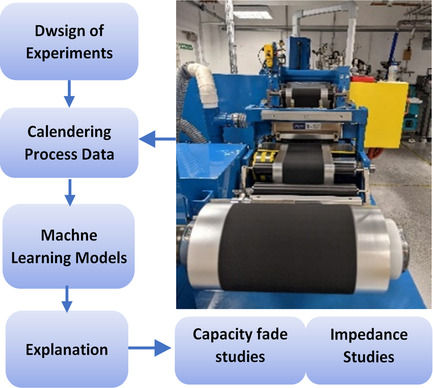
Explainable machine learning in combination with design of experiments and real data is utilized for in-depth study of the calendering process during Li-ion battery manufacturing. With focus on the cell's impedance and capacity fade, it is shown that the calendering process control factors such as calendering temperature and gap have different levels of importance across various C-Rates and states of charge.
Reactive Ion Etching Activating TiO2 Substrate for Planar Heterojunction Sb2S3 Solar Cells with 6.06% Efficiency
- First Published: 06 October 2022
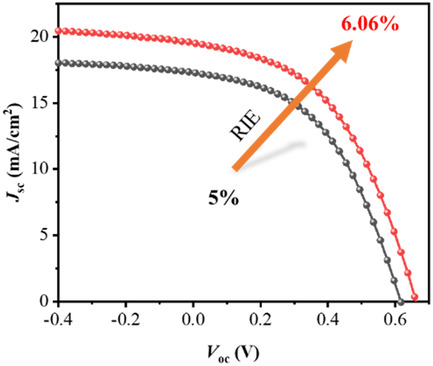
A strategy of reactive ion etching (RIE) treatment to TiO2 surface is developed, activating the TiO2 surface for Sb2S3 deposition without any heterointerlayer incorporation. The optimal device power conversion efficiency is over 6%, top value among planar TiO2/Sb2S3 solar cells with a new record short-circuit current density (JSC) of ≈19.4 mA cm−2.
Detached Vertical (Al,Ga)N Nanowires to Realize the Flexible Ultraviolet Photodetector with High Ultraviolet/Visible Reject Ratio and Detectivity
- First Published: 08 October 2022
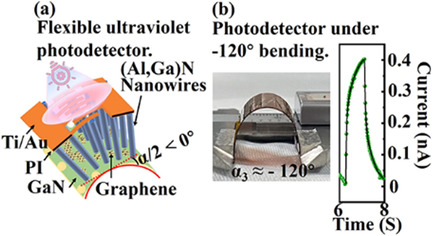
It is very novel to realize a solid-state flexible ultraviolet (UV) photodetector (PD) by detaching vertical (Al,Ga)N nanowires. Compared with those of state-of-the-art PDs, this detector has high UV/visible reject ratio and detectivity. In addition, the device still maintains good stability and periodicity after −120° bending, which has great potential for applications.
Solar-Light-Assisted Lithium-Ion Storage Using Solar-Light Absorbing Material
- First Published: 07 October 2022
Electrodeless Nanogenerator for Dust Recover
- First Published: 08 October 2022
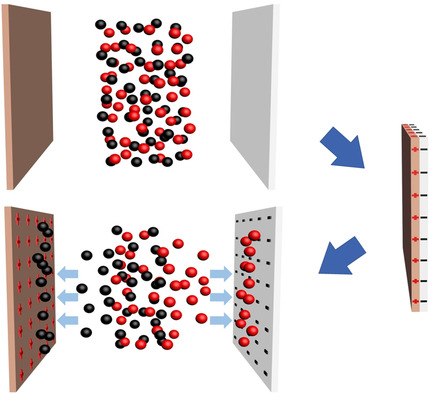
A triboelectric blackboard eraser is designed, and its surface potential of after rubbing with the blackboard can be as high as −24.8 kV, which can effectively adsorb tiny dust. Compared with a traditional blackboard eraser, it can supplement the charge while erasing the blackboard without precharging. Such electrodeless design may pave a new way for new nanogenerator design.
Microarchitectures of Carbon Nanotubes for Reversible Na Plating/Stripping Toward the Development of Room-Temperature Na–S Batteries
- First Published: 13 October 2022
Biomass Waste-Derived Solar Evaporator for Efficient and Low-Cost Water Evaporation
- First Published: 08 October 2022
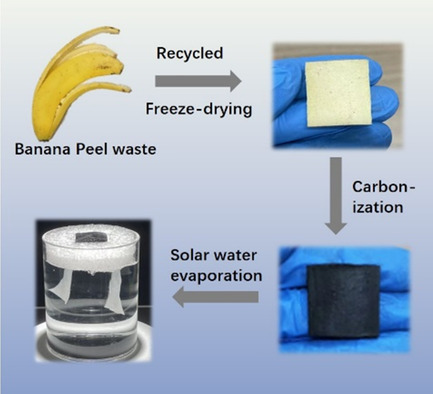
A recycled waste banana peel-derived solar evaporator is fabricated, delivering a high solar water evaporation rate of 1.35 kg m−2 h−1 with a solar-to-vapor conversion efficiency of 87.5% under 1 sun irradiation. The renewable, low-cost, and efficient solar evaporator herein presents promising potential for applications in sustainable solar water treatment.
Additive Engineering for High-Performance Two-Dimensional Dion–Jacobson Pb–Sn Alloyed Perovskite Solar Cells
- First Published: 12 October 2022
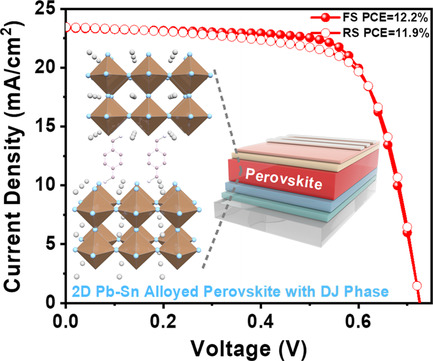
Herein, the nonlinear bandgap behavior of 2D Pb–Sn perovskite materials is demonstrated. Moreover, MACl is introduced to improve the film quality of Dion–Jacobson phase 2D Pb–Sn perovskite with (PhDMA)MA4(Pb0.5Sn0.5)5I16, resulting in the suppression of the defect density and the nonradiative recombination. Consequently, high power conversion efficiency of 12.2% is achieved for 2D Pb–Sn perovskite solar cell.
Controlling Product Distribution of CO2 Reduction on CuO-Based Gas Diffusion Electrodes by Manipulating Back Pressure
- First Published: 12 October 2022
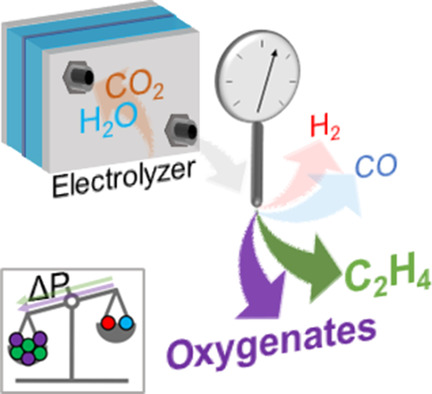
Back pressure enables control over product selectivity toward C2+ products, up to a Faradaic selectivity of 60%. It enhances the stability of the CO2RR significantly, from 36 to 72 h of stable ethylene production. Its easy implementability renders it a promising tool to be used in commercialized CO2RR cells in the future.
Flexible Zinc-Ion Hybrid Capacitor Based on Interface-Engineered Textile of Waste Face Masks
- First Published: 14 October 2022

The flexible zinc-ion hybrid capacitors (ZHCs) are proposed for wearable systems using waste face masks (WFMs) as the substrate and separator. The ZHC prepared under optimum conditions has good mechanical and electrochemical properties. This work provides a facile strategy to construct low-cost textile-based flexible ZHCs from WFMs.
Solvation and Stabilization of Superior Alanate Nanostructures
- First Published: 19 October 2022
Triboelectric Nanogenerator Based on Biowaste Tribopositive Delonix Regia Flowers Powder
- First Published: 12 October 2022

The energy crisis and environmental pollution are largely attending challenges across the globe. Herein, the Delonix regia flowers for the triboelectric nanogenerator are developed. The proposed device exhibits excellent performance in self-powering devices, which concludes that the proposed work paves the path toward sustainable electronic technology.
Design Optimization of Energy-Storing Hybrid Supercapacitor Composite for Electric Vehicle's Body Panel
- First Published: 18 October 2022
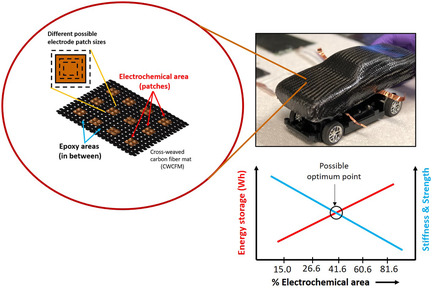
Design of the multifunctional “energized composite for electric vehicles” has been optimized using ANSYS simulation and experimental methods to obtain maximum electrical charge storage while maintaining a minimum mechanical strength. This has been achieved through evaluating the performance of the composite at various ratios of electrochemical area and epoxy area in each laminate of the composite.
Improved Proton Adsorption and Charge Separation on Cadmium Sulfides for Photocatalytic Hydrogen Production
- First Published: 19 October 2022
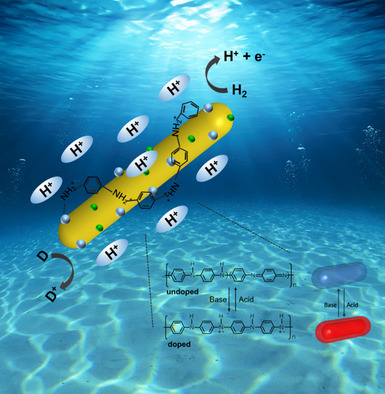
A polyaniline (PANI)/NCPP/CdS (PANI/NiCoP/NiCoPi/CdS) hybrid is described as a noble metal-free visible light-driven photocatalyst. This hybrid not only facilitates charge separation and transfer owing to the formation of a heterojunction, but also improves the local concentration of H+ on the surface of catalysts due to the formation of the protonated amine groups on PANI, beneficial to hydrogen evolution reaction.
Biomass-Inspired Solar Evaporator for Simultaneous Steam and Power Generation Enhanced by Thermal-Electric Effect
- First Published: 26 October 2022
Optimal Sizing of Combined Stationary Solid Oxide Fuel Cell-Based Polygeneration System and Electric Vehicle Charging Considering Multi-Criteria Decisions
- First Published: 21 October 2022
Effect of Electrolyte Concentration on Electrochemical Performance of ZnWO4 Nanosheets Array
- First Published: 25 October 2022
In Situ Growth of NiCo Layered Double Hydroxide on Biomass Waste-Based Substrate: A Novel Material with 3D Interconnected Structure as Electrodes for Supercapacitors
- First Published: 28 October 2022
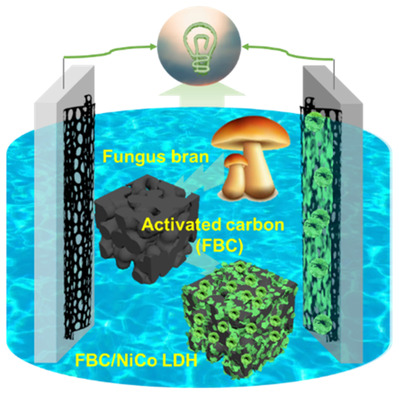
KMnO4-activated fungus bran-derived carbon (FBC) is used as a carbon-based substrate, which is compounded with NiCo layered double hydroxide to form a structurally stable carbon–metal composite (FBC/NCL) electrode material. The asymmetric supercapacitor assembled by FBC/NCL and FBC shows excellent electrochemical performance in the aqueous electrolyte.
The Role of Porous Carbon Inserts on the Performance of Polymer Electrolyte Membrane Fuel Cells: A Parametric Numerical Study
- First Published: 28 October 2022

A computational fluid dynamic study is conducted to investigate the effects of using porous carbon inserts (PCIs) on water management and the performance of proton exchange membrane fuel cells. The results show that employing PCI leads to a more efficient water removal from the fuel cell and higher oxygen transport throughout the cell, which subsequently enhances the fuel cell performance.
A Stretchable and Healable Gelatin Hydrogel Assisted by Hofmeister Effect for All-in-One Flexible Supercapacitor
- First Published: 01 November 2022
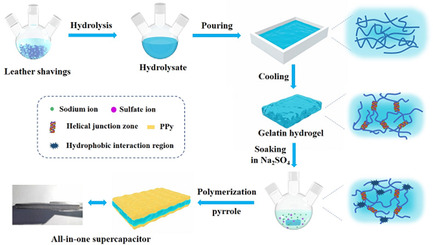
A stretchable and healable all-in-one supercapacitor (SC) consisting of the gelatin hydrogel electrolytes and polypyrrole (PPy) electrodes is constructed via the Hofmeister series. The all-in-one SCs exhibit excellent tensile property, ultrahigh capacitance, outstanding energy density, and reliable self-healing properties.
Design of Quadruple-Layer Antireflection Coating for AlGaInP/AlGaAs/GaAs Three-Junction Solar Cell
- First Published: 01 November 2022
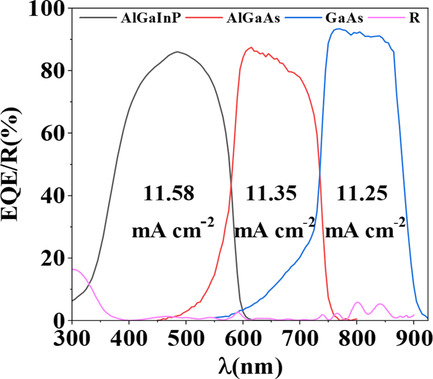
Better performance of MgF2/ZnS/MgF2/ZnS quadruple-layer antireflection coatings has been confirmed compared with other antireflection coatings (ARCs). Fabricated AlGaInP/AlGaAs/GaAs cell with this ARC reduces the average reflectivity to only 1.59% in 300–900 nm. Photo-generated current density in each subcell has been improved especially in the top cell due to the significant reduction of reflectivity in 300–400 nm.
Highly Efficient Nonfullerene Organic Solar Cells with Nickel Oxide Hole-Transporting Layer: Using Dipole-Induced Energy-Level Modification
- First Published: 03 November 2022
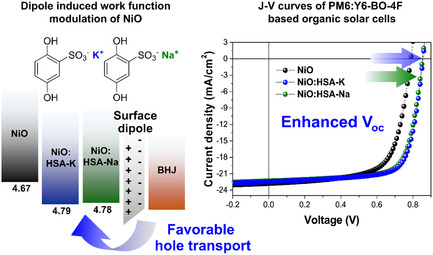
Hydroquinone sulfonic acid potassium and sodium salt are utilized with NiO to generate a dipole-induced work function shift and enhance hole transport capability. Using this modified NiO, highly efficient nonfullerene acceptor organic solar cells based on PM6:Y6-BO-4F showing 14.19% power conversion efficiency with a very high open-circuit voltage of 0.86 V are achieved.
Enhanced Supercapacitive Properties of Mixed Oxide Nanotubes Grown by Anodization of Ti–Fe Alloys
- First Published: 03 November 2022
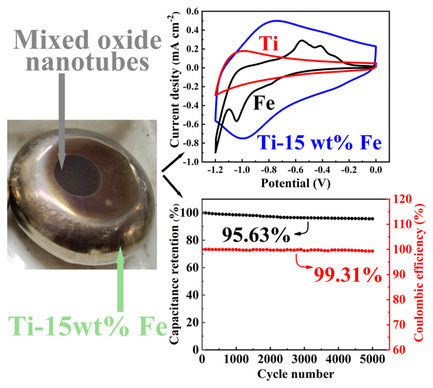
The anodization behaviors of Ti–Fe alloys and electrochemical properties of the mixed oxide nanotubes obtained by anodization are reported. The mixed oxide nanotubes have completely different electrochemical behaviors compared to both the pure TiO2 and the pure Fe2O3. The mixed oxide nanotubes on Ti–15 wt%Fe show the maximum capacitance with high rate capability and excellent cycling stability.




